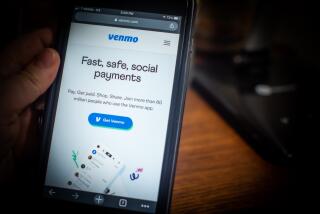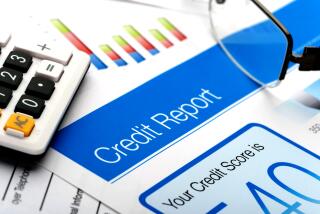Saying goodbye to your bank
- Share via
Thinking of breaking up with your big bank? You’re not alone.
Bank of America’s recent move to slap customers with a $5 monthly fee to use their debit cards has unleashed a torrent of ill will against the nation’s financial giants. Fed up with enriching executives and shareholders, some account holders are vowing to shift their business to smaller banks or neighborhood credit unions.
But before you march down to your branch to close your account, take a deep breath. Switching in haste could cost you if you skip the fine print or don’t understand your own financial habits. Friendly teller service doesn’t matter if what you really need is a nationwide ATM network. Free checking is fabulous, but not if it comes with a lot of strings.
Breaking up is easy. Finding a financial partnership that’s more satisfying could prove trickier. Like any relationship, deciding whether to stay or to go requires some careful thinking.
“You have to do homework. You have to ask questions. It’s going to take some time,” said Norma Garcia, a senior attorney for Consumers Union. “But it’s time worth spending if you wind up with a bank that treats you like you want to be treated.”
Know what you’ve got
It may sound obvious, but first check out your own bank statement or head to your bank’s website. A lot of consumers have no idea what they’re paying for, according to Rob Kaplan-Sherman, president of the services division at Research Intelligence Group, a Fort Washington, Penn., market research firm.
Pew Charitable Trusts analyzed 265 different checking programs offered by the 10 biggest U.S. banks and found 49 types of fees in all. Those included overdraft-protection charges that averaged $35 per transaction, as well as bounced-check penalties, ATM charges, copying fees and charges to deposit large amounts of coins. At least one bank said it would deduct fees to cover the cost of its expenses in legal disputes — regardless of the outcome.
Most consumers have to worry about only a handful of those. But it’s worth printing them out so you can shop around. The most likely things to consider are: monthly account fees, fees for using ATMs, fees for using debit cards and fees for overdraft protection or for covering overdrafts from a linked savings account.
Of course, fees are only part of a banking relationship. Many customers have multiple bank accounts, direct deposit, automatic bill payments and a mortgage or other loans with their institutions.
Multiple services tend to bind consumers to their banks — a term known as “stickiness” — especially if they have set up automatic payments or deposits. It will take some work to undo them at one bank and set them up at another. So be prepared for some hassle.
Consider other things you might need. Maybe it’s an auto loan — something that a lot of business-oriented community banks don’t provide. Or maybe it’s the huge ATM networks available from the major banks. If the latter is important to you, be sure to find out whether the small bank or credit union you’re considering belongs to a cooperative ATM network, which could give you access to thousands of fee-free ATMs.
Small institutions pride themselves on personal service. But maybe you do all your banking online, which makes you a candidate for Internet banks.
You’ll also want to ask whether the bank plans to start charging for use of its debit cards, which have overtaken checks as the preferred method of accessing money in bank accounts. Following the outcry over BofA’s new fee, which kicks in next year, JPMorgan Chase & Co., Citigroup Inc. and some other big banks have said they’ll steer clear of that charge for now. But many large institutions haven’t made that pledge, so it’s worth being vigilant.
“Consumers are tightening their belts,” Kaplan-Sherman said. “When they hear that a free tool they have become very dependent on is going to start generating a charge, it raises a question: Should they change their behavior at the bank they have, or change banks?”
Love the one you’re with?
Unwinding a banking relationship can be complicated.
Assuming you’re not already hopelessly estranged, you might find it easier to stick with your bank and still avoid fees by changing your behavior, Consumers Union’s Garcia said.
For example, you might be miffed about Bank of America’s upcoming debit-card charge. But you can avoid paying it by not making any debit purchases (use of the bank’s ATMs remains free).
BofA is also phasing in an $8.95 monthly charge for basic checking that once was free with direct deposit of paychecks. But you can avoid the fee by depositing $2,000 a month, maintaining a balance totaling $5,000 in linked accounts, or using a linked Bank of America credit card at least once a month. Or, if you’re comfortable with making all your deposits and withdrawals over the Internet, via mobile banking or at an ATM, you can opt for BofA’s online-only free checking.
Another important consideration is overdraft protection.
Under revised regulations, banks need customers’ permission to cover debit and ATM overdrafts at up to $35 a pop. Many customers have opted in, but most advocates say it’s better not to. Instead, ask about cheaper alternatives such as having a linked savings account or credit line to cover balance-busting debits.
Here’s another basic rule: The more products and services you use, the more valuable you are as a customer — and the more likely it is the bank has an interest in making you happy.
Chase, for example, charges $10 a month for basic checking. But it lets you off the hook for that fee if you directly deposit $500 a month, maintain a minimum daily checking balance of $1,500 or have a total of $5,000 in linked accounts.
Choosing a new partner
If you’ve simply had enough of your big bank, it’s time to consider other options: Internet banks, smaller community and regional banks, and not-for-profit credit unions.
Internet banks like ING Direct, Ally Bank and State Farm Bank may be a no-brainer for those already accustomed to doing much of their research and shopping online.
These banks have lower costs because they don’t have physical branches. Their free accounts even may include perks like covering ATM fees for customers with direct deposit.
But if you want to talk face to face with someone about a home loan or investments, or when you’re confused about a service or a charge, they’re not the place for you.
Credit unions, by contrast, are set up for such hands-on service at a low cost. Owned by members who are linked by jobs or geography, their core focus is on consumer accounts, although some these days are doing more small-business lending.
The broadening of criteria for membership has made credit unions available to nearly anyone. Southern California’s largest include SchoolsFirst Federal of Santa Ana, open to all school and college workers; and Pasadena’s Wescom, which is available to anyone who lives or works in Los Angeles, Orange, Riverside, San Bernardino, Ventura, San Diego or Santa Barbara counties.
To get around the limited number of branches and ATMs at credit unions, check whether they belong to the Co-op Network, which entitles members to withdraw funds without charge at more than 28,000 ATMs in the U.S. and Canada. Smartphone apps and text-message programs have made it far easier to find these ATMs than in the past, in case you find yourself needing cash in an unfamiliar place.
You can find a credit union near you at https://www.asmarterchoice.org.
Community banks can be a little trickier, since many of them are focused on small businesses and not consumers. You can try online screening services like https://www.findabetterbank.com, but it may be better to check the websites of candidates in your area: The first thing you see on Fullerton Community Bank’s site, for example, are promotions for “totally free checking.”
Or just walk in and talk to the bankers — something community banks say they make it easy to do. If they say they have free checking, make sure to ask whether there’s a minimum balance you must maintain.
And these days, just keep your eyes and ears open: Plenty of small banks and credit unions are angling for your attention. LA Financial Credit Union, which is open to any L.A. County resident, says its new member applications jumped tenfold after it began advertising no-minimum free checking and debit cards, along with a “break up with my bank” website. The credit union has advertised the campaign heavily in recent weeks (including in the Los Angeles Times).
San Diego County’s PacTrust Bank, which has promoted free checking and fee-free debit cards, plans to stay open late Saturday, Nov. 5, which is what a national Internet campaign has targeted as Bank Transfer Day. The community bank says it will pay $60 — the annual amount Bank of America plans to charge debit-card users — to people who open certain accounts on that day.
Making the switch
Once you’ve picked a new institution, don’t immediately sever your ties with your old bank. You’ll need a transition period to make sure direct deposit, automatic bill payment and other services transfer smoothly. Be aware that some banks charge you to close accounts, especially those that have been open only a short time.
Consumers Union offers a host of tips on the website DefendYourDollars.org. Here’s a condensed version.
• Open your new checking account with a small deposit.
• List all automatic payments and deposits at your old checking account.
• Ask your employer to reroute any direct-deposited paychecks to your new account.
• Once you know when your direct deposits will transfer, reschedule each automatic payment or debit to come out of your new account.
• Leave some cash in your old account for at least a month to ensure payment should you happen to forget something.
• When you’re certain all automatic payments and deposits are switched over, electronically transfer the final funds from your old account to the new one. Your new bank or credit union can help you with this.
• Once the transfer clears, follow the procedures for closing an account at your old financial institution. And make sure to obtain written confirmation that your old bank indeed has closed out that account.
That will help send a farewell message as you depart, says Garcia of Consumers Union: “We’re not just a bank account number. We’re real people who respond to how we’re treated.”
More to Read
Inside the business of entertainment
The Wide Shot brings you news, analysis and insights on everything from streaming wars to production — and what it all means for the future.
You may occasionally receive promotional content from the Los Angeles Times.











